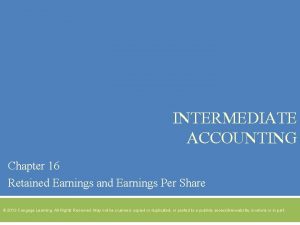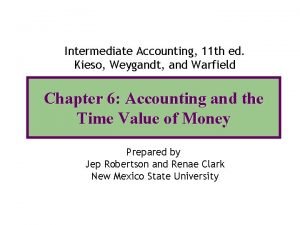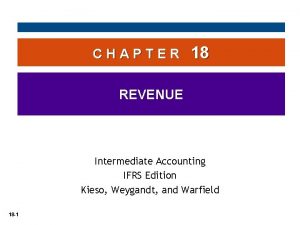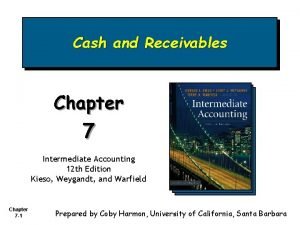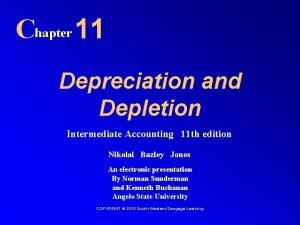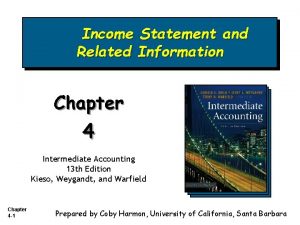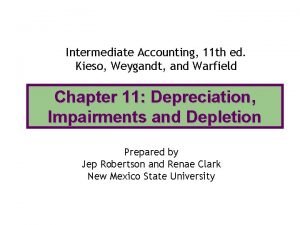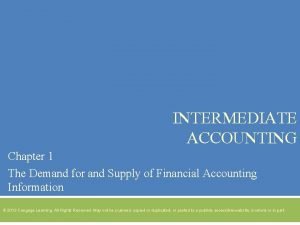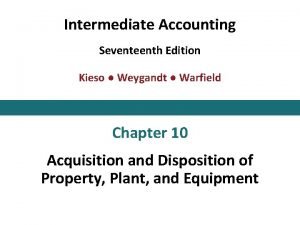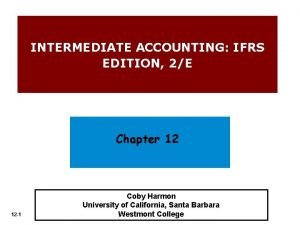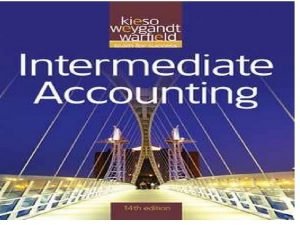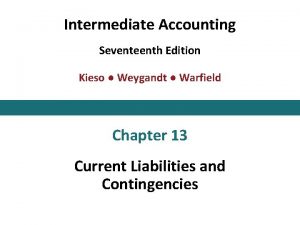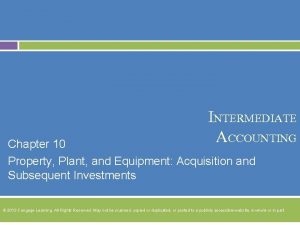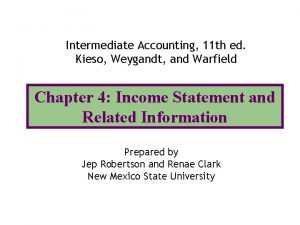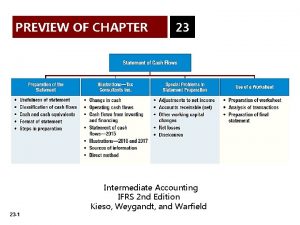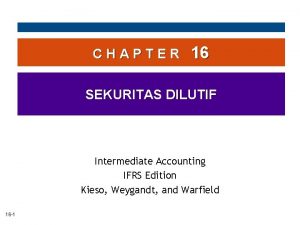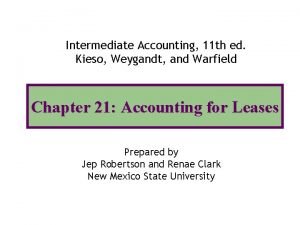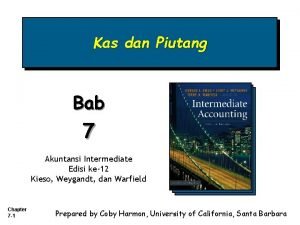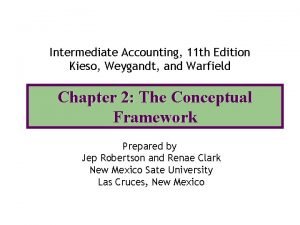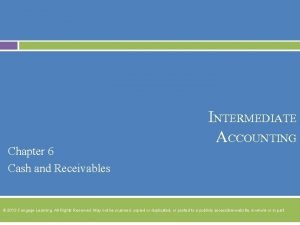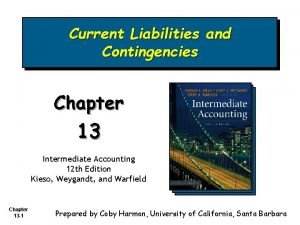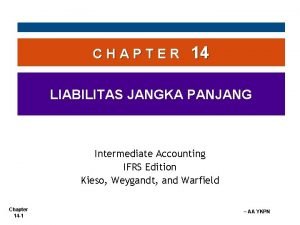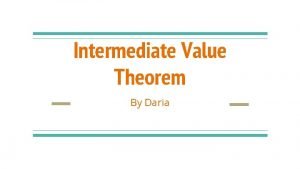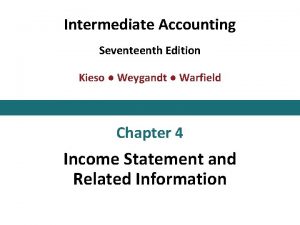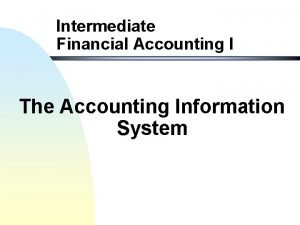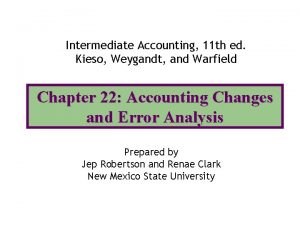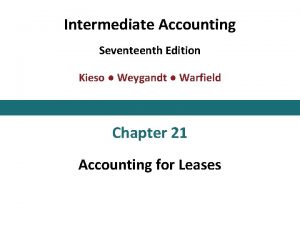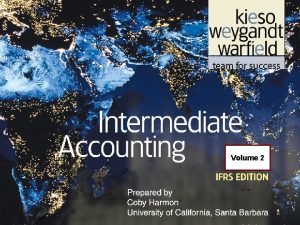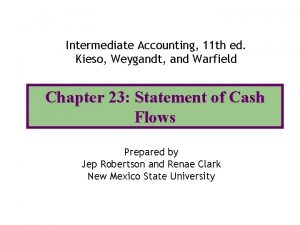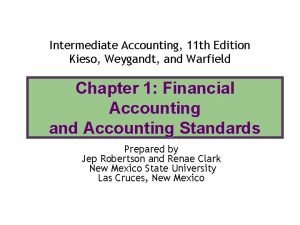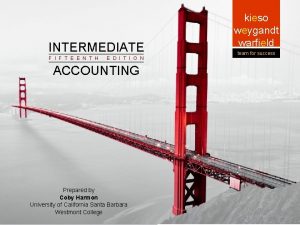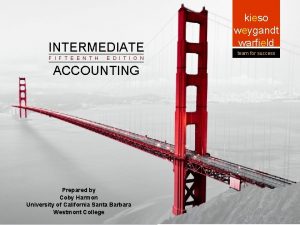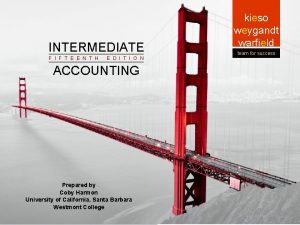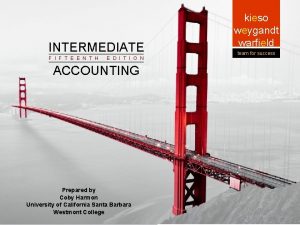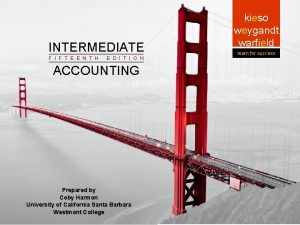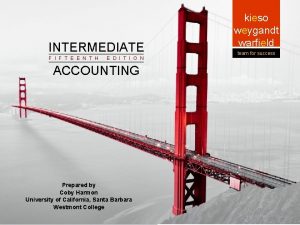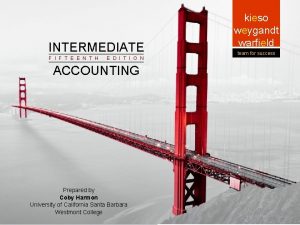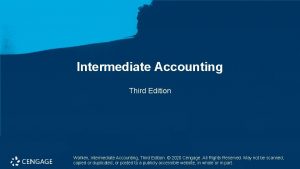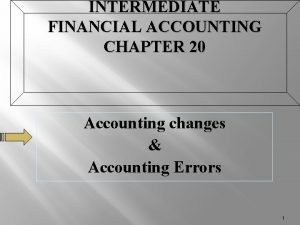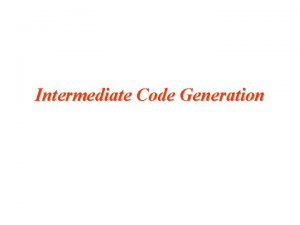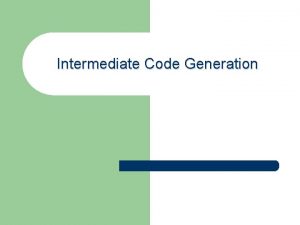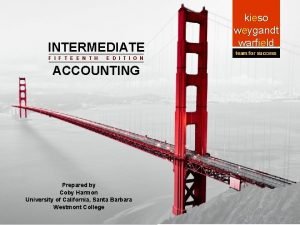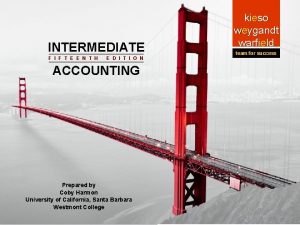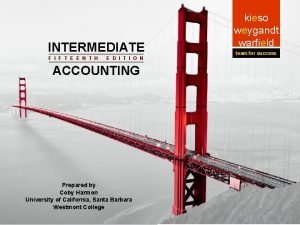INTERMEDIATE Intermediate ACCOUNTING Intermediate Accounting F I F












































- Slides: 44

INTERMEDIATE Intermediate ACCOUNTING Intermediate Accounting F I F T E E N T H 7 -1 E D I T I O N Prepared by Coby Harmon University of California Santa Barbara University of California, Santa Barbara Westmont College kieso weygandt warfield team for success

Cash What is Cash? 7 -2 u Most liquid asset. u Standard medium of exchange. u Basis for measuring and accounting for all items. u Current asset. u Examples: coin, currency, available funds on deposit at the bank, money orders, certified checks, cashier’s checks, personal checks, bank drafts and savings accounts. LO 1 Identify items considered cash.

Cash Reporting Cash Equivalents Short-term, highly liquid investments that are both a) readily convertible to cash, and b) so near their maturity that they present insignificant risk of changes in value. Examples: Treasury bills, Commercial paper, and Money market funds. 7 -3 LO 2 Indicate how to report cash and related items.

Reporting Cash Restricted Cash Companies segregate restricted cash from “regular” cash. Examples, restricted for: (1) plant expansion, (2) retirement of long-term debt, and compensating balances. (3) Illustration 7 -1 7 -4 LO 2

Reporting Cash Bank Overdrafts Company writes a check for more than the amount in its cash account. 7 -5 u Generally reported as a current liability. u Offset against other cash accounts only when accounts are with the same bank. LO 2 Indicate how to report cash and related items.

Cash-Related Items Illustration 7 -2 7 -6 LO 2

Exercise 1 -a Cash includes the following: 1. Commercial savings account— First National Bank of Yojimbo 1. Commercial checking account— First National Bank of Yojimbo 2. Money market fund—Volonte 5. Petty cash 11. Commercial Paper (cash equivalent) 12. Currency and coin on hand Cash reported on December 31, 2014, balance sheet 7 -7 600, 000 900, 000 5, 000 1, 000 2, 100, 000 7, 700 $8, 608, 700

Exercise 1 -b 3. Travel advances (reimbursed by employee)* *If not reimbursed, charge to prepaid expense. should be reported as receivable—employee in the amount of $180, 000. 4. Cash restricted in the amount of $1, 500, 000 for the retirement of long-term debt should be reported as a noncurrent asset identified as “Cash restricted for retirement of long-term debt. ” 6. An IOU from Marianne Koch should be reported as an account receivable in the amount of $190, 000. 7 -8

Exercise 1 -b Continues 7. The bank overdraft of $110, 000 should be reported as a current liability. ****If cash is present in another account in the same bank on which the overdraft occurred, offsetting is required. 8. Certificates of deposits of $500, 000 each should be classified as temporary investments. 9. Postdated check of $125, 000 should be reported as an accounts receivable. 10. The compensating balance requirement does not affect the balance in cash. A note disclosure indicating the arrangement and the amounts involved should be described in the notes. 7 -9

Accounts Receivables - Claims held against customers and others for money, goods, or services. 7 -10 Oral promises of the purchaser to pay for goods and services sold. Written promises to pay a sum of money on a specified future date. Accounts Receivable Notes Receivable LO 3 Define receivables and identify the different types of receivables.

Accounts Receivable Nontrade Receivables 1. Advances to officers and employees. 2. Advances to subsidiaries. 3. Deposits paid to cover potential damages or losses. 4. Deposits paid as a guarantee of performance or payment. 5. Dividends and interest receivable. 6. Claims against: Insurance companies for casualties sustained; defendants under suit; governmental bodies for tax refunds; common carriers for damaged or lost goods; creditors for returned, damaged, or lost goods; customers for returnable items (crates, containers, etc. ). 7 -11 LO 3 Define receivables and identify the different types of receivables.

Recognition of Accounts Receivables Trade Discounts u 7 -12 Reductions from the list price. u Not recognized in the accounting records. u Customers are billed net of discounts. 10 % Discount for new Retail Store Customers LO 4 Explain accounting issues related to recognition of accounts receivable.

Recognition of Accounts Receivables Cash Discounts (Sales Discounts) 7 -13 u Offered to induce prompt payment. u Gross Method vs. Net Method. Payment terms are 2/10, n/30 LO 4 Explain accounting issues related to recognition of accounts receivable.

Recognition of Accounts Receivables Cash Discounts (Sales Discounts) 7 -14 Illustration 7 -4 LO 4 Explain accounting issues related to recognition of accounts receivable.

Exercise 5 (1) June 3 June 12 (2) June 3 June 12 (b) July 29 7 -15 Accounts Receivable—Chester Sales Revenue 3, 000 Cash Sales Discounts ($3, 000 X 2%) A/R—Chester 2, 940 60 Accounts Receivable—Chester Sales Revenue ($3, 000 X 98%) 2, 940 Cash Accounts Receivable—Chester 3, 000 Accounts Receivable—Chester Sales Discounts Forfeited 3, 000 2, 940 60 (Note to instructor: Sales discounts forfeited could have been recognized at the time the discount period lapsed. The company, however, would probably not record this forfeiture until final cash settlement. )

Accounts Receivables 7 -16 LO 4 Explain accounting issues related to recognition of accounts receivable.

Accounts Receivables Alternate Presentation 7 -17 LO 4 Explain accounting issues related to recognition of accounts receivable.

Accounts Receivable Valuation of Accounts Receivable u Reporting of receivables involves 1) classification and 2) valuation on the balance sheet. 7 -18 u Classification involves determining the length of time each receivable will be outstanding. u Value and report short-term receivables at net realizable value. LO 5 Explain accounting issues related to valuation of accounts receivable.

Valuation of Accounts Receivable Uncollectible Accounts Receivable u Record credit losses as debits to Bad Debt Expense (or Uncollectible Accounts Expense). u Normal and necessary risk of doing business on credit. u Two methods to account for uncollectible accounts: 1) the direct write-off method and 2) the allowance method. 7 -19 LO 5 Explain accounting issues related to valuation of accounts receivable.

Valuation of Accounts Receivable Methods of Accounting for Uncollectible Accounts Direct Write-Off Theoretically deficient: Losses are estimated: u No matching. u Percentage-of-sales. u Receivable not stated at cash realizable value. u Percentage-of-receivables. u GAAP requires when material in amount. u 7 -20 Allowance Method Not GAAP when material in amount. LO 5 Explain accounting issues related to valuation of accounts receivable.

Valuation of Accounts Receivable Illustration 7 -6 The percentage-of-sales basis results in a better matching of expenses with revenues 7 -21 The percentage-of-receivables basis produces the better estimate of net realizable value LO 5 Explain accounting issues related to valuation of accounts receivable.

Valuation of Accounts Receivable Percentage-of-Sales Approach 7 -22 u Percentage based upon past experience and anticipate credit policy. u Achieves better matching of expenses with revenues. u Any balance in Allowance for Doubtful Accounts is ignored. LO 5 Explain accounting issues related to valuation of accounts receivable.

Valuation of Accounts Receivable Percentage-of-Receivables Approach u Not matching. u Reports estimate of receivables at realizable value. Companies may apply this method using 7 -23 u one composite rate, or u an aging schedule using different rates. LO 5 Explain accounting issues related to valuation of accounts receivable.

Exercise 7 (a) Bad Debt Expense 8, 500 Allowance for Doubtful Accounts 8, 500* *. 01 X ($900, 000 – $50, 000) = $8, 500 (b) Bad Debt Expense 3, 000 Allowance for Doubtful Accounts *Step 1: . 05 account) *Step 2: $5, 000 account to $5, 000 credit balance) 7 -24 3, 000*

Notes Receivable Supported by a formal promissory note. 7 -25 u Written promise to pay a certain sum of money at a specific future date. u A negotiable instrument. u Maker signs in favor of a Payee. u Interest-bearing (has a stated rate of interest) OR u Zero-interest-bearing (interest included in face amount). LO 6 Explain accounting issues related to recognition and valuation of notes receivable.

Notes Receivable Generally originate from: 7 -26 u Customers who need to extend payment period of an outstanding receivable. u High-risk or new customers. u Loans to employees and subsidiaries. u Sales of property, plant, and equipment. u Lending transactions (majority of notes). LO 6 Explain accounting issues related to recognition and valuation of notes receivable.

Recognition of Notes Receivable 7 -27 Short-Term Long-Term Record at Face Value, less allowance Record at Present Value of cash expected to be collected Interest Rates Note Issued at Stated rate = Market rate Face Value Stated rate > Market rate Premium Stated rate < Market rate Discount LO 6

Exercise 12 7/1 7/5 Accounts Receivable—Harding Co. Sales Revenue ($8, 000 X 98%) Cash [$9, 000 X (1 –. 09)] 8, 190 Loss on Sale of Receivables 810 Accounts Receivable ($9, 000 X 98%) Sales Discounts Forfeited 7, 840 8, 820 180 (Note: It is possible that the company already recorded the Sales Discounts Forfeited. In this case, the credit to Accounts Receivable would be for $9, 000. The same point applies to the next entry as well. ) 7 -28

7/9 Accounts Receivable 180 Sales Discounts Forfeited ($9, 000 X 2%) Cash Interest Expense ($6, 000 X 6%) Notes Payable 180 5, 640 360 6, 000 7/11 Account Receivable—Harding Co 160 Sales Discounts Forfeited 160 ($8, 000 X 2%) This entry may be made at the next time financial statements are prepared. Also, it may occur on 12/29 when Harding Company’s receivable is adjusted. 12/29 Allowance for Doubtful Accounts 7, 200 Accounts Receivable—Harding Co. [$7, 840 + $160 = $8, 000; $8, 000 – (10% X $8, 000) = $7, 200] 7 -29 7, 200

Recognition of Notes Receivable Notes Received for Property, Goods, or Services In a bargained transaction entered into at arm’s length, the stated interest rate is presumed to be fair unless: 1. No interest rate is stated, or 2. Stated interest rate is unreasonable, or 3. Face amount of the note is materially different from the current cash sales price. 7 -30 LO 6 Explain accounting issues related to recognition and valuation of notes receivable.

Disposition of Accounts and Notes Receivable Owner may transfer accounts or notes receivables to another company for cash. Reasons: u Competition. u Sell receivables because money is tight. u Billing and collection are time-consuming and costly. Transfer accomplished by: 7 -31 u Secured borrowing. u Sale of receivables. LO 8 Explain accounting issues related to disposition of accounts and notes receivable.

Disposition of Accounts and Notes Receivable Sales of Receivables Sale Without Recourse u Purchaser assumes risk of collection. u Transfer is outright sale of receivable. u Seller records loss on sale. Sale With Recourse 7 -32 u Seller guarantees payment to purchaser. u Financial components approach used to record transfer. LO 8 Explain accounting issues related to disposition of accounts and notes receivable.

Sales of Receivables Factors are finance companies or banks that buy receivables from businesses for a fee. Illustration 7 -17 7 -33 LO 8

Exercise 5 -13 (a) Cash Interest Expense Notes Payable 192, 000 8, 000* 200, 000 *2% X $400, 000 = $8, 000 (b) Cash 350, 000 Accounts Receivable (c) Notes Payable Interest Expense Cash *10% X $200, 000 X 3/12 = $5, 000 7 -34 350, 000 200, 000 5, 000* 205, 000

Exercise 15 Computation of net proceeds: Cash received Less: Recourse liability Net proceeds $160, 000 1, 000 $159, 000 Computation of gain or loss: Carrying value Net proceeds Loss on sale of receivables The following journal entry would be made: Cash 160, 000 Loss on Sale of Receivables 41, 000 Recourse Liability Accounts Receivable 7 -35 $200, 000 159, 000 $ 41, 000 200, 000

Exercise 17 (a) July 1 Cash 283, 500 Due from Factor 12, 000* Loss on Sale of Receivables 4, 500** Accounts Receivable 300, 000 **(4% X $300, 000) = $12, 000 **(1 1/2% X $300, 000) = $4, 500 (b) July 1 Accounts Receivable Due to JFK Corp. Interest Revenue Cash 7 -36 300, 000 12, 000 4, 500 283, 500

Presentation and Analysis Presentation of Receivables 1. Segregate the different types of receivables that a company possesses, if material. 2. Appropriately offset the valuation accounts against the proper receivable accounts. 3. Determine that receivables classified in the current assets section will be converted into cash within the year or the operating cycle, whichever is longer. 4. Disclose any loss contingencies that exist on the receivables. 5. Disclose any receivables designated or pledged as collateral. 6. Disclose the nature of credit risk inherent in the receivables. 7 -37 LO 9 Describe how to report and analyze receivables.

APPENDIX 7 A CASH CONTROLS Using Bank Accounts To obtain desired control objectives, a company can vary the number and location of banks and the types of accounts. 7 -38 u General checking account u Collection float. u Lockbox accounts u Imprest bank accounts LO 10 Explain common techniques employed to control cash.

APPENDIX 7 A CASH CONTROLS The Imprest Petty Cash System To pay small amounts for miscellaneous expenses. Steps: 1. Record $300 transfer of funds to petty cash: Petty Cash 300 2. The petty cash custodian obtains signed receipts from each individual to whom he or she pays cash. 7 -39 LO 10 Explain common techniques employed to control cash.

APPENDIX 7 A CASH CONTROLS Reconciliation of Bank Balances Schedule explaining any differences between the bank’s and the company’s records of cash. Reconciling Items: 1. Deposits in transit. 2. Outstanding checks. 3. Bank charges and credits. Time Lags 4. Bank or Depositor errors. 7 -40 LO 10 Explain common techniques employed to control cash.

Exercise 22 1. April 1 2. April 10 3. April 20 7 -41 Petty Cash 200 Freight-In (or Invertory) Supplies Expense Postage Expense Accounts Receivable—Emp Miscellaneous Expense Cash Over and Short Cash ($200 – $27) Petty Cash 60 25 33 17 36 2 173 100

Problem 2 1. Net sales Percentage Bad debt expense 1, 200, 000 1 1/2% $ 18, 000 2. Accounts receivable Amounts estimated to be uncollectible Net realizable value 3. Allowance for doubtful accounts 1/1/14 Establishment of accounts written off in prior years Customer accounts written off in 2014 Bad debt expense for 2014 ($2, 400, 000 X 3%) Allowance for doubtful accounts 12/31/14 7 -42 1, 750, 000 (180, 000) 1, 570, 000 17, 000 8, 000 (30, 000) ( 72, 000 67, 000

Problem 2 4. Bad debt expense for 2014 Customer accounts written off Allowance for doubtful accounts balance 12/31/14 Accounts receivable, net of allowance Allowance for doubtful accounts balance 12/31/14 Accounts receivable, before deducting allowance for doubtful accounts 5. Accounts receivable Percentage Bad debt expense, before adjustment Allowance for doubtful accounts (debit balance) Bad debt expense, as adjusted 7 -43 84, 000 (24, 000) 60, 000 950, 000 60, 000 1, 010, 000 3% 9, 300 14, 000 23, 300

Problem 6 -1 - Cash 136, 800* Sales Discounts 1, 200 Accounts Receivable *[$138, 000 – ($60, 000 X 2%)] 138, 000 – 2– Accounts Receivable 5, 300 Allowance for Doubtful Accounts Cash 5, 300 Accounts Receivable 5, 300 – 3– Allowance for Doubtful Accounts Receivable 17, 500 – 4– 7 -44 Bad Debt Expense 14, 900 Allowance for Doubtful Accounts *($17, 300 + $5, 300 – $17, 500 = $5, 100; $20, 000 – $5, 100 = $14, 900) 14, 900*
 Intermediate accounting chapter 16
Intermediate accounting chapter 16 Intermediate accounting kieso
Intermediate accounting kieso Net realizable value formula
Net realizable value formula Intermediate accounting chapter 18
Intermediate accounting chapter 18 Cash and receivables intermediate accounting
Cash and receivables intermediate accounting Intermediate accounting chapter 11
Intermediate accounting chapter 11 Intermediate accounting chapter 4
Intermediate accounting chapter 4 Impairment in finance meaning
Impairment in finance meaning Tax loss carry forward
Tax loss carry forward Intermediate accounting chapter 1
Intermediate accounting chapter 1 Commercial substance
Commercial substance Patent impairment
Patent impairment Intermediate accounting chapter 1
Intermediate accounting chapter 1 Revenue recognition intermediate accounting
Revenue recognition intermediate accounting Warranty liability journal entry
Warranty liability journal entry Contoh soal ekuitas pemegang saham
Contoh soal ekuitas pemegang saham Chapter 10 property plant and equipment
Chapter 10 property plant and equipment Intermediate accounting kieso
Intermediate accounting kieso Chapter 23 statement of cash flows
Chapter 23 statement of cash flows Kieso chapter 16 bahasa indonesia
Kieso chapter 16 bahasa indonesia Chapter 3 intermediate accounting
Chapter 3 intermediate accounting Chapter 12 intermediate accounting
Chapter 12 intermediate accounting Intermediate accounting chapter 1
Intermediate accounting chapter 1 Capital lease 4 criteria
Capital lease 4 criteria Bab 7 kas dan piutang
Bab 7 kas dan piutang Primary qualities of accounting information
Primary qualities of accounting information Cash and receivables intermediate accounting
Cash and receivables intermediate accounting Liablities
Liablities Current liabilities and contingencies
Current liabilities and contingencies Chapter 14 intermediate accounting kieso bahasa indonesia
Chapter 14 intermediate accounting kieso bahasa indonesia Khan academy intermediate accounting
Khan academy intermediate accounting Income statement discontinued operations
Income statement discontinued operations Accounts payable subsidiary ledger
Accounts payable subsidiary ledger Chapter 2 conceptual framework
Chapter 2 conceptual framework Intermediate accounting kieso
Intermediate accounting kieso Intermediate accounting
Intermediate accounting Intermediate accounting leases
Intermediate accounting leases Chapter 15 intermediate accounting
Chapter 15 intermediate accounting Chapter 15 intermediate accounting
Chapter 15 intermediate accounting Under ifrs the presumption is that equity investments are
Under ifrs the presumption is that equity investments are Intermediate accounting kieso
Intermediate accounting kieso Secured borrowing journal entries
Secured borrowing journal entries Intermediate accounting
Intermediate accounting Conceptual framework levels
Conceptual framework levels What's residual value
What's residual value
